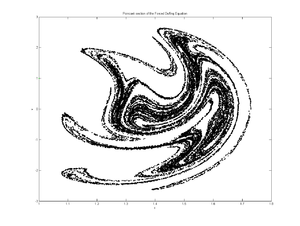- Duffing equation
-
The Duffing equation is a non-linear second-order differential equation used to model certain damped and driven oscillators. The equation is given by
where the (unknown) function x=x(t) is the displacement at time t,
 is the first derivative of x with respect to time, i.e. velocity, and
is the first derivative of x with respect to time, i.e. velocity, and  is the second time-derivative of x, i.e. acceleration. The numbers δ, α, β, γ and ω are given constants.
is the second time-derivative of x, i.e. acceleration. The numbers δ, α, β, γ and ω are given constants.The equation describes the motion of a damped oscillator with a more complicated potential than in simple harmonic motion (which corresponds to the case β=δ=0); in physical terms, it models, for example, a spring pendulum whose spring's stiffness does not exactly obey Hooke's law.
The Duffing equation is an example of a dynamical system that exhibits chaotic behavior. Moreover the Duffing system presents in the frequency response the jump resonance phenomenon that is a sort of frequency hysteresis behaviour.
Parameters
- δ controls the size of the damping (friction).
- α controls the size of the restoring force.
- β controls the amount of non-linearity in the restoring force. If β = 0, the Duffing equation describes a damped and driven simple harmonic oscillator.
- γ controls the amplitude of the periodic driving force. If γ = 0 we have a system without driving force.
- ω controls the frequency of the periodic driving force.
Methods of solution
In general, the Duffing equation does not admit an exact symbolic solution. However, many approximate methods work well:
- Expansion in a Fourier series will provide an equation of motion to arbitrary precision.
- The x3 term, also called the Duffing term, can be approximated as small and the system treated as a perturbed simple harmonic oscillator.
- The Frobenius method yields a complicated but workable solution.
- Any of the various numeric methods such as Euler's method and Runge-Kutta can be used.
In the special case of the undamped (δ = 0) and undrived (γ = 0) Duffing equation, an exact solution can be obtained using Jacobi's elliptic functions.
External links

This applied mathematics-related article is a stub. You can help Wikipedia by expanding it.


